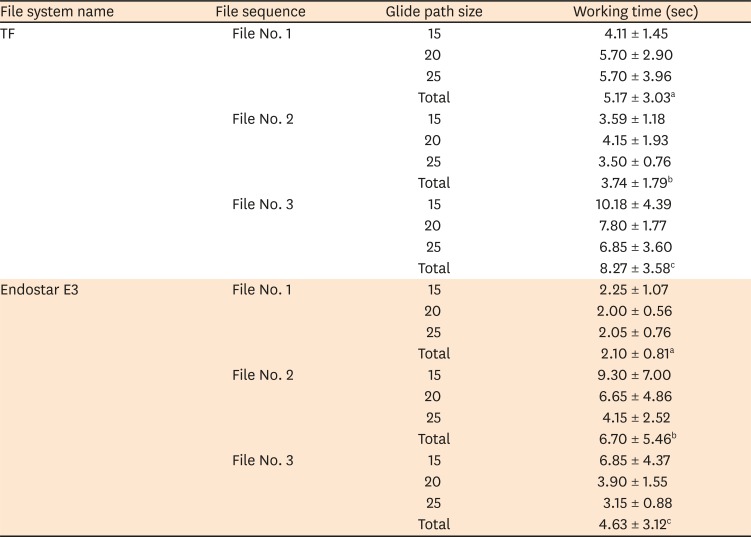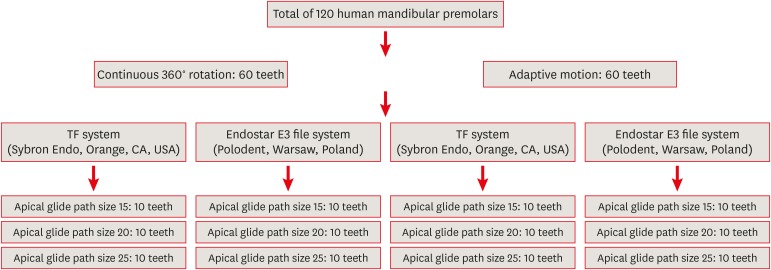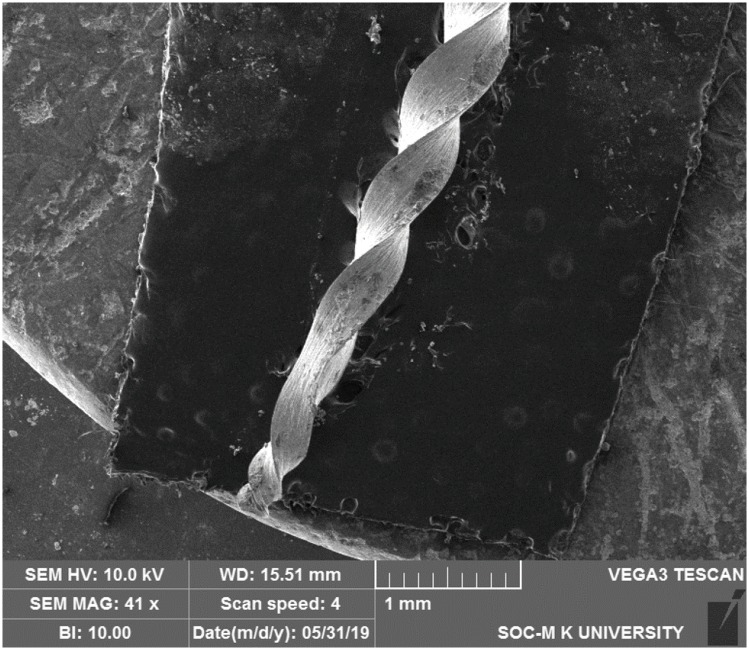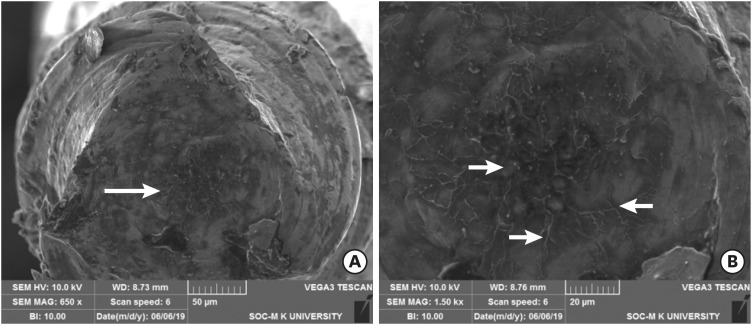1. Park SK, Kim YJ, Shon WJ, You SY, Moon YM, Kim HC, Lee W. Clinical efficiency and reusability of the reciprocating nickel-titanium instruments according to the root canal anatomy. Scanning. 2014; 36:246–251. PMID:
23630105.

2. Peters OA. Current challenges and concepts in the preparation of root canal systems: a review. J Endod. 2004; 30:559–567. PMID:
15273636.

3. Schäfer E, Oitzinger M. Cutting efficiency of five different types of rotary nickel-titanium instruments. J Endod. 2008; 34:198–200. PMID:
18215681.

4. Bui TB, Mitchell JC, Baumgartner JC. Effect of electropolishing ProFile nickel-titanium rotary instruments on cyclic fatigue resistance, torsional resistance, and cutting efficiency. J Endod. 2008; 34:190–193. PMID:
18215679.

5. Fayyad DM, Elhakim Elgendy AA. Cutting efficiency of twisted versus machined nickel-titanium endodontic files. J Endod. 2011; 37:1143–1146. PMID:
21763910.

6. Berutti E, Cantatore G, Castellucci A, Chiandussi G, Pera F, Migliaretti G, Pasqualini D. Use of nickel-titanium rotary PathFile to create the glide path: comparison with manual preflaring in simulated root canals. J Endod. 2009; 35:408–412. PMID:
19249606.

7. Blum JY, Cohen A, Machtou P, Micallef JP. Analysis of forces developed during mechanical preparation of extracted teeth using Profile NiTi rotary instruments. Int Endod J. 1999; 32:24–31. PMID:
10356466.

8. Peters OA, Peters CI, Schönenberger K, Barbakow F. ProTaper rotary root canal preparation: assessment of torque and force in relation to canal anatomy. Int Endod J. 2003; 36:93–99. PMID:
12657152.

9. Yared GM, Bou Dagher FE, Machtou P. Influence of rotational speed, torque and operator's proficiency on ProFile failures. Int Endod J. 2001; 34:47–53. PMID:
11307380.

10. Berutti E, Negro AR, Lendini M, Pasqualini D. Influence of manual preflaring and torque on the failure rate of ProTaper rotary instruments. J Endod. 2004; 30:228–230. PMID:
15085052.

11. Patiño PV, Biedma BM, Liébana CR, Cantatore G, Bahillo JG. The influence of a manual glide path on the separation rate of NiTi rotary instruments. J Endod. 2005; 31:114–116. PMID:
15671822.
12. Yared G. Canal preparation using only one Ni-Ti rotary instrument: preliminary observations. Int Endod J. 2008; 41:339–344. PMID:
18081803.

13. Çapar ID, Arslan H. A review of instrumentation kinematics of engine-driven nickel-titanium instruments. Int Endod J. 2016; 49:119–135. PMID:
25630977.

14. Schneider SW. A comparison of canal preparations in straight and curved root canals. Oral Surg Oral Med Oral Pathol. 1971; 32:271–275. PMID:
5284110.

15. Sattapan B, Nervo GJ, Palamara JE, Messer HH. Defects in rotary nickel-titanium files after clinical use. J Endod. 2000; 26:161–165. PMID:
11199711.

16. Plotino G, Ahmed HM, Grande NM, Cohen S, Bukiet F. Current assessment of reciprocation in endodontic preparation: a comprehensive review--part II: properties and effectiveness. J Endod. 2015; 41:1939–1950. PMID:
26480824.

17. Hwang YH, Bae KS, Baek SH, Kum KY, Lee W, Shon WJ, Chang SW. Shaping ability of the conventional nickel-titanium and reciprocating nickel-titanium file systems: a comparative study using micro-computed tomography. J Endod. 2014; 40:1186–1189. PMID:
25069930.

18. Gu LS, Kim JR, Ling J, Choi KK, Pashley DH, Tay FR. Review of contemporary irrigant agitation techniques and devices. J Endod. 2009; 35:791–804. PMID:
19482174.

19. Jin SY, Lee W, Kang MK, Hur B, Kim HC. Single file reciprocating technique using conventional nickel-titanium rotary endodontic files. Scanning. 2013; 35:349–354. PMID:
23364950.

20. Kim HC, Hwang YJ, Jung DW, You SY, Kim HC, Lee W. Micro-computed tomography and scanning electron microscopy comparisons of two nickel-titanium rotary root canal instruments used with reciprocating motion. Scanning. 2013; 35:112–118. PMID:
22833465.

21. Franco V, Fabiani C, Taschieri S, Malentacca A, Bortolin M, Del Fabbro M. Investigation on the shaping ability of nickel-titanium files when used with a reciprocating motion. J Endod. 2011; 37:1398–1401. PMID:
21924190.

22. Marks Duarte P, Barcellos da Silva P, Alcalde MP, Vivan RR, Rosa RA, Duarte MA, Só MV. Canal transportation, centering ability, and cyclic fatigue promoted by Twisted File Adaptive and Navigator EVO instruments at different motions. J Endod. 2018; 44:1425–1429. PMID:
30078572.

23. Al-Obaida MI, Merdad K, Alanazi MS, Altwaijry H, AlFaraj M, Alkhamis AA, Al-Madi EM. Comparison of cyclic fatigue resistance of 5 heat-treated nickel-titanium reciprocating systems in canals with single and double curvatures. J Endod. 2019; 45:1237–1241. PMID:
31420109.

24. Higuera O, Plotino G, Tocci L, Carrillo G, Gambarini G, Jaramillo DE. Cyclic fatigue resistance of 3 different nickel-titanium reciprocating instruments in artificial canals. J Endod. 2015; 41:913–915. PMID:
25771139.

25. Zupanc J, Vahdat-Pajouh N, Schäfer E. New thermomechanically treated NiTi alloys - a review. Int Endod J. 2018; 51:1088–1103. PMID:
29574784.

26. Meena D, Ramyadharshini , Nivedha V, Sherwood A, Kumar S. Influences of continuous rotation and TF adaptive motion on the resistance of different retreatment file systems to deformation and fracture: an in vitro study. J Oper Dent Endod. 2018; 3:71–78.
27. Kim HC, Kim HJ, Lee CJ, Kim BM, Park JK, Versluis A. Mechanical response of nickel-titanium instruments with different cross-sectional designs during shaping of simulated curved canals. Int Endod J. 2009; 42:593–602. PMID:
19467053.

28. Gündoğar M, Özyürek T. Cyclic fatigue resistance of OneShape, HyFlex EDM, WaveOne Gold, and Reciproc Blue nickel-titanium instruments. J Endod. 2017; 43:1192–1196. PMID:
28527845.

29. Ha JH, Park SS. Influence of glide path on the screw-in effect and torque of nickel-titanium rotary files in simulated resin root canals. Restor Dent Endod. 2012; 37:215–219. PMID:
23429968.








 PDF
PDF Citation
Citation Print
Print







 XML Download
XML Download